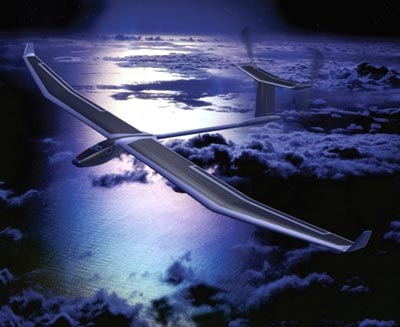
Pollution and utilization off fossil fuel is not just attributed to roadways but also airways. Having introduced many alternatives for roadways, attention is now inclined to airways. Two Swiss aviators unveiled a solar powered prototype, this morning that will fly around the globe in 2011. This aircraft called Solar Impulse has ultra thin solar cells incorporated on their wings that will trap the solar energy and convert it to electrical energy to power the four electric motors built in. the energy stored during the day is used for its flight at night. The £42m Solar Impulse will measure about 262ft from wing tip to wing tip, giving it a similar wingspan to that of the new A380 superjumbo. But then, unlike the superjumbo, that can flay 800 passengers, Solar Impulse has space for only the aviator in the cock pit. Besides, it can fly at a maximum speed of 40mph while superjumbo flies 560mph. 
Having been built of carbon fiber, it is not expected to withstand turbulence and jet-streams. Unlike the traditional planes, that can use the jet-streams to propel themselves faster, the Solar Impulse can be crushed. The solar cells harness the energy from the sun and store it in the battery onboard. There is no complaint about cloudy days also because the aircraft is designed to fly at an altitude of 42,000ft which is usually over the clouds, about 10,000ft higher than what a conventional aircraft can fly. This Solar Impulse is expected to be an immense success with no such advancements having been made in the past three decades. However, it looks like for specific reasons, the modifications and mending that need to be done would be prolonged. The two Swiss intend to test the flight in 2009 with a smaller model with a wingspan of 197ft that can fly only 36 hours at a height of 27,000ft. Being a solar powered aircraft, it would make more sense to fly along the equator to ensure trapping maximum solar energy. A team of about 50 weathermen, air traffic controllers and simulation engineers, a support crew and a portable hangar will supervise the and monitor the flight.
We must presume a number of technical improvements in the field of solar cells and batteries before we can make the round-the-world flight,
says Borschberg.
‘At the moment, it could not be done, but in 2011 we will do it.’
Although the intention was to make it eco-friendly, I have my doubts as to whether it would be an equivalent replacement to conventional aircraft in terms of safety and efficiency. We wouldn’t know that until the aircraft is subject to intensive testing. If it does hit the aerodrome, I would assume it would give passengers the stisfaction of a “greener” flight. via : Timesonline




